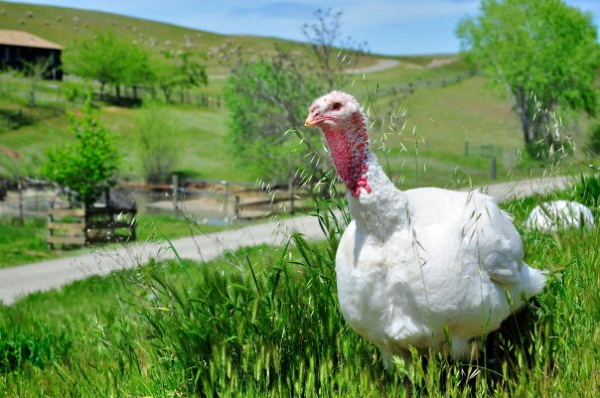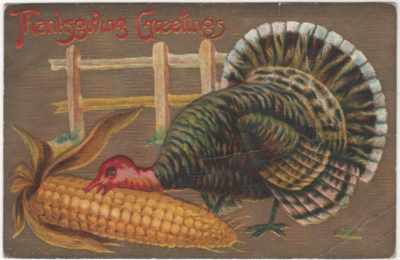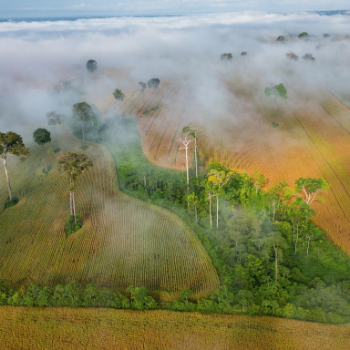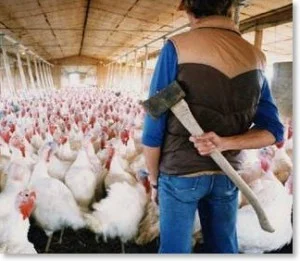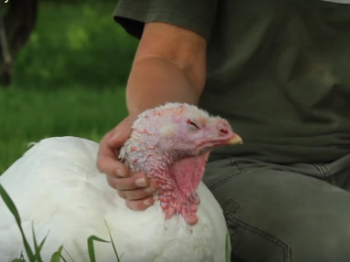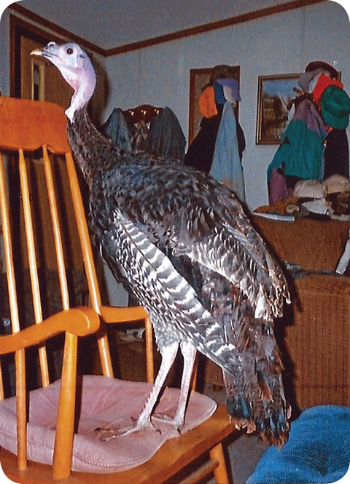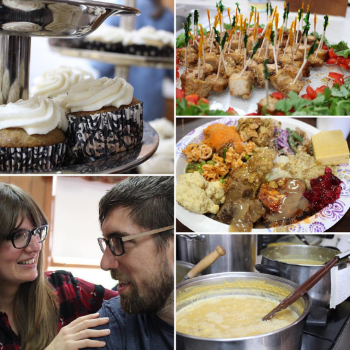ThanksLiving: Is Thanksgiving Without the Turkey for the Birds?
Photo: inhabitat.com
As Jesse Eisenberg recently explained to Conan O’Brien, many are calling their vegan Thanksgiving celebration “Thanksliving.” But is it really possible to give thanks for the blessing of the harvest without consuming a dead turkey with dried bread stuffed into his or her anal cavity? Let’s find out.
A Corny Tradition
Corn, a main player in the harvest we’re ostensibly giving thanks for, was a cherished staple crop for many native tribes and subsequently for the Pilgrims. What do farmed turkeys mostly eat? Corn. If this seems like an appropriate celebratory use of the stuff, read on.
Per Scientific American (we like science), the massive amount of corn fed to farmed animals suffers major losses of calories and protein along the way. “What this all means is that little of the corn crop actually ends up feeding American people. It’s just math.” Good thing we're donating food to hungry people when we're not wastefully shoving it down the gullets of animals.
For every 200 calories of corn the average modern domestic turkey eats, only 100 calories become edible portions of his or her flesh. The feed conversion ratio (FCR) of turkeys raised in more pastoral settings is often worse, and that of larger animals like pigs and cows is even more atrocious.
So what are the impacts of growing such epic amounts of corn? It’s not pretty. The below picture from National Geographic’s “The Future of Food” shows a section of Amazon rainforest cleared to grow corn. In total, 91% of deforested Amazon is cleared for grazing animals and growing their feed crops like corn, soy, and grain – all while 21,000 human being starve to death EACH DAY.
Photo: National Geographic
In the US, the corn system uses more land (and irrigation water) than any other crop, equivalent to the size of the state of California. The National Corn Grower’s Association says 80% is fed to livestock worldwide. They’re happy about this because it means they can grow and sell unreasonably large amounts of corn. Like, say, enough to fatten up tens of billions of entirely discretionary animals like giant turkeys and 1-ton bovines while human beings starve to death.
In a nutshell, an 18-pound turkey is actually a 36-pound pile of corn, minus the fiber, micronutrients, and energy-giving carbs that were present in the corn.
Our well-intentioned tradition of feeding the hungry while simultaneously creating demand for tens of billions of crop-inhaling animals – none of whom go remotely hungry – is counterproductive, illogical, and harmful.
Turkeys Would Say Thanks, But No Thanks
Despite the fact that the origins of the Thanksgiving tradition have nothing to do with turkeys, the charming gobbles of 37 million baby galliformes are silenced around this time of year. (Yes, they are babies. They average 16-18 weeks, or 5 months, of age when they are butchered.)
As psychologist Melanie Joy explains, violent ideologies are the product of an invisible system. Although enabled by well-meaning friends and family, the institutionalized bloodshed of tens of millions of individual toms and hens to “give thanks” is an undeniably violent, counterintuitive ideology. It stays entrenched by remaining invisible, unnamed, and unquestioned.
Despite the onslaught of images of happy living turkeys, including those aimed at children, most people are totally sheltered from what it takes to turn living turkeys into headless, legless, internal organ-less carcasses. This is because most couldn’t stomach or tolerate it. The only footage we see of animal factories are illegally obtained by activists, which are then discredited as being altered or portraying an isolated incident.
So why, pray tell, don’t they just show us their own footage of how turkeys are intensively confined before being beheaded?
As Craig and I once did, you may make an effort to purchase meat with humane labels and acknowledge your own disappointing hypocrisy in continuing to either frequently or infrequently consume the products of CAFOs (Concentrated Animal Feeding Operations) because they are so pervasive and much more affordable.
But please think about it. Would you recoil any less at the idea of slitting a turkey’s throat just because of the conditions he or she was briefly raised in during life? You owe it to yourself and the turkeys to find out. Take a moment to watch how they are killed under the most “humane” of circumstances. As Khaiti Kahleck of LTD Farm explains, “The muscles as they move as they die are very strong. And it’s almost startling to feel that energy as a life force leaving.” Even more startling is the idea of such a needless betrayal of our feathered friends.
Killing for nourishment when it's not for survival is actually killing for pleasure. It's unnecessary. Although humane-washing has successfully distracted us from this, these small farmers, whether struggling or not, receive a paycheck from the act of forcefully and violently ending someone’s brief existence on this Earth – someone brought into existence just for that purpose. Those with access to and autonomy over our food choices can forego this process by choosing plant-based foods that use resources far more efficiently.
What to Do?
“There’s some strange thing about when a person meets a turkey and realizes just how sweet they are,” explains Susie Coston, who takes care of animals rescued from the slaughter industry at a vegan farm sanctuary. As she explains, the turkeys have deep bonds with other specific birds. They vocalize with their besties back and forth when they can’t see each other. She describes most of them as curious but shy. Hildy the turkey loved to sit with Susie for hours and hours being pet.
Hildy
One woman, Kathryn King, even explains how she ended up inadvertently becoming a turkey’s surrogate mom when one of the poults (baby turkey) she bought was weak and needed extra nurturing. Even once grown, Peeper would follow her around, fly up onto her lap to cuddle when she watched TV, and would lay his face by her face for her to pet and stroke him for hours. Much like any other pet, he had favorite toys, daily routines, and would come when called by name. When he passed away, the mourning process was no different than had he been the cherished family dog.
Peeper
Nothing about Hildy or Peeper is different from the turkeys people eat without ever considering the unique individual on their plate. Animals are not anonymous production units, even if we pretend they are. The animals don’t have to change for us to live vegan, but we do need to change our own perspective.
I have come to understand that the questions I am asked at holidays are, in a way, questions people are asking themselves. For example:
Don’t you miss having the turkey at Thanksgiving?
Would I miss having the turkey at Thanksgiving?
What’s Thanksgiving without the turkey?
Could I celebrate Thanksgiving without the turkey?
What do you eat instead?
What would I eat instead?
It can be impossible not to sound defensive. Colleen Patrick Goudreau has a helpful suggestion: just ask an open question back instead. “Well, do you think you would miss having the turkey at Thanksgiving?” I find people usually say it’s not their favorite part of the Thanksgiving spread but they eat it because it’s there.
On holidays, we all want to be surrounded by friends and family, eat delicious food, and collapse into a satisfied haze afterward. Animal flesh or fluid is in no way required for any of this. Trust me.
Photos from the amazing pre-Thanksgiving 100% vegan potluck feast we recently attended in Mendon, MA benefitting Maple Farm Sanctuary (the owners are featured in the documentary Peaceable Kingdom!)
Here are several approaches for celebrating a vegan Thanksgiving:
Have your own enjoyable, delicious ThanksLiving. (And no, this doesn’t need to involve a lecture about the evils of factory farming or a turkey-shaped alternative, the latter of which apparently enrages Conan O’Brien more than the actual killing of 37 billion US turkeys each year.) This can also involve going to a farm sanctuary to experience the joys of living turkeys firsthand. The real thrill, as they say, is not to kill.
Opt out of any Thanksgiving celebration in which turkey is on the menu, as is the idea behind this year’s #LiberationPledge. The idea, modeled after how past social injustices have been overcome, is that we are born into a violent status quo that takes courage to remove ourselves from, so we need support if we are going to take a minority stand – but to create social change we need to put traditionalists on the defense by creating zones of nonviolence and asking others to do the same.
Attend a party that will have a turkey carcass as the guest of dishonor and bring delicious vegan options to share, helping others understand that they do have a choice to opt out of needless violence and resource waste.
So yes, I think we’ve proven it’s not only possible to give thanks without chopping off someone’s head, but that doing so is actually a far more appropriate and effective use of the very harvest we’re giving thanks for. Here’s to a wonderful ThanksLiving!
Vegan Thanksgiving recipe ideas:
Eat Plants / Drink Beer (us): Roasted Seitan with Root Vegetables
Serious Eats: Vegetables Wellington (The Ultimate Vegan Plant-Based Holiday Roast)
Huffington Post: 42 Vegan Thanksgiving Recipes That'll Steal The Turkey's Show
Buzzfeed: 41 Delicious Vegan Thanksgiving Recipes
Photo: Serious Eats: Vegetables Wellington (The Ultimate Vegan Plant-Based Holiday Roast)
